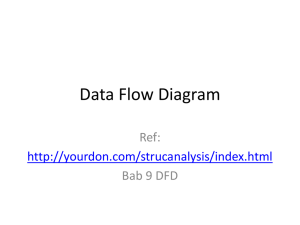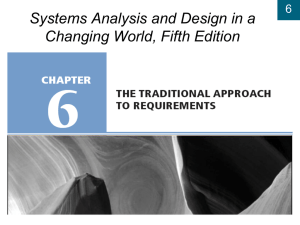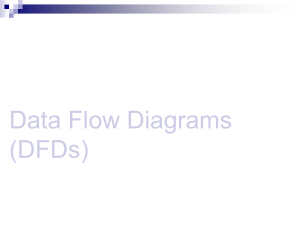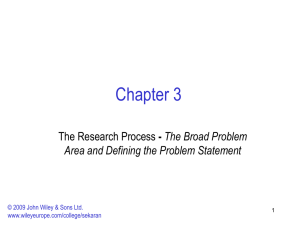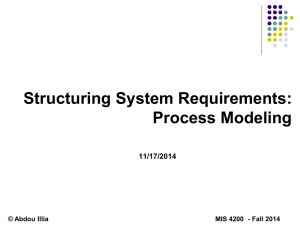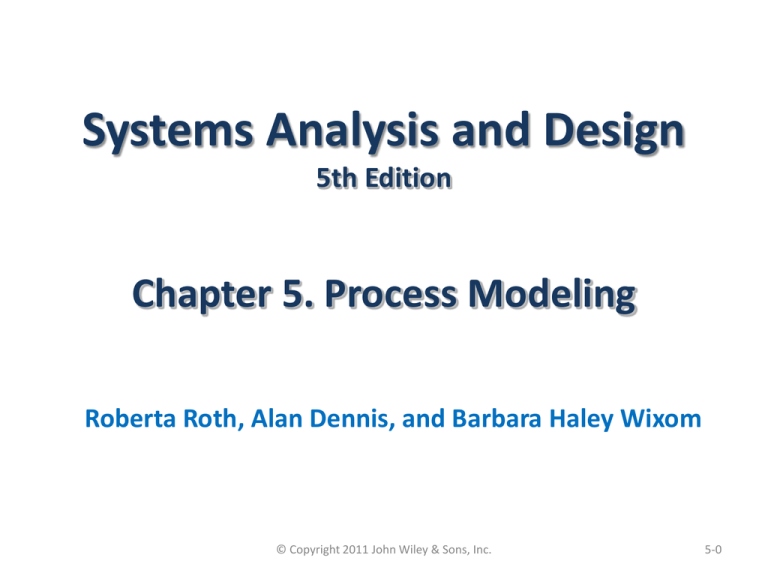
Systems Analysis and Design
5th Edition
Chapter 5. Process Modeling
Roberta Roth, Alan Dennis, and Barbara Haley Wixom
© Copyright 2011 John Wiley & Sons, Inc.
5-0
© Copyright 2011 John Wiley & Sons, Inc.
5-1
© Copyright 2011 John Wiley & Sons, Inc.
5-2
Chapter 5 Outline
Data flow diagrams.
- Reading data flow diagrams
- Elements of data flow diagrams
- Using data flow diagrams to define
business processes
- Process descriptions
Creating data flow diagrams.
© Copyright 2011 John Wiley & Sons, Inc.
5-3
INTRODUCTION
A process model can be used to further
clarify the requirements definition and
use cases.
A process model is a graphical way of
representing how a business system
should operate.
A process model can be used to
document the as-is system or the to-be
system, whether computerized or not.
© Copyright 2011 John Wiley & Sons, Inc.
5-4
(cont’d)
Data flow diagramming is a technique
that diagrams the business processes and
the data that pass among them.
Logical process models describe
processes without suggesting how they
are conducted.
Physical process models provide
information that is needed to build the
system.
© Copyright 2011 John Wiley & Sons, Inc.
5-5
DATA FLOW DIAGRAMS (DFDs)
Reading Data Flow Diagrams
© Copyright 2011 John Wiley & Sons, Inc.
5-6
Elements of Data Flow Diagrams
Process – A process is an activity or a function
performed for some specific business reason.
Data Flow – A data flow is a single piece of data,
or a logical collection of several pieces of
information.
Data Store – A data store is a collection of data
that is stored in some way.
External Entity – An external entity is a person,
organization, organization unit, or system that is
external to the system, but interacts with it.
© Copyright 2011 John Wiley & Sons, Inc.
5-7
(cont’d)
© Copyright 2011 John Wiley & Sons, Inc.
5-8
Using DFDs to Define Business
Processes
Business processes are too complex
to be explained in one DFD.
One important principle in process
modeling with DFDs is the
decomposition of the business
process into a series of DFDs, each
representing a lower level of detail.
© Copyright 2011 John Wiley & Sons, Inc.
5-9
(cont’d)
Decomposition
© Copyright 2011 John Wiley & Sons, Inc.
5-10
Context Diagram
The first DFD in every business process
is the context diagram.
It shows the entire system in context
with its environment.
The context diagram shows the overall
business process as just one process
and shows the data flows to and from
external entities.
© Copyright 2011 John Wiley & Sons, Inc.
5-11
Level 0 Diagram
The level 0 diagram (or level 0 DFD) shows all the
major high-level processes of the system and how
they are interrelated.
The Level 0 diagram shows all the processes at the
first level the numbering, the data stores, external
entities, and data flows among them.
A key concept: Balancing
- Ensuring that all information presented in a DFD at
one level is accurately represented in the next-level
DFD.
A process model has one and only one level 0 DFD.
© Copyright 2011 John Wiley & Sons, Inc.
5-12
Level 1 Diagrams
Each process on the level 0 DFD can be
decomposed into a more explicit DFD called
level 1 diagram (or level 1 DFD).
The set of children and the parent are
identical; they are simply different ways of
looking at the same thing.
It is important to ensure that level 0 and level
1 DFDs are balanced.
© Copyright 2011 John Wiley & Sons, Inc.
5-13
(cont’d)
All process models have as many
level 1 diagrams as there are
processes on the level 0 diagram.
The parent process and the children
processes are numbered
consistently.
© Copyright 2011 John Wiley & Sons, Inc.
5-14
Level 2 Diagrams
The next level of decomposition: a
level 2 diagram, or level 2 DFD.
A level 2 DFD shows all processes,
data flows, and data stores that
comprise a single process on the
level 1 diagram.
It is important to ensure that level 1
and level 2 DFDs are balanced.
© Copyright 2011 John Wiley & Sons, Inc.
5-15
Alternative Data Flows
A process can produce different data
flows under different circumstance.
We show both data flows and use
the process description to explain
why they are alternatives.
© Copyright 2011 John Wiley & Sons, Inc.
5-16
Process Descriptions
The purpose of the process descriptions is to
explain what the process does and provide
additional information that the DFD does not
provide.
Three techniques are commonly used to
describe more complex processing logic:
– Structured English
– Decision trees
– Decision tables
© Copyright 2011 John Wiley & Sons, Inc.
5-17
CREATING DATA FLOW DIAGRAMS
DFDs start with the information in the use
cases and the requirements definition.
Generally, the set of DFDs integrates the
individual use cases.
The project team takes the use cases and
rewrites them as DFDs, following the DFD
formal rules about symbols and syntax.
CASE tools are used to draw process
models.
© Copyright 2011 John Wiley & Sons, Inc.
5-18
(cont’d)
Example of the use of CASE Tools
© Copyright 2011 John Wiley & Sons, Inc.
5-19
(cont’d)
1.
2.
3.
Build the context diagram.
Create DFD fragments for each use case.
Organize the DFD fragments into level 0
diagram.
4. Develop level 1 DFDs based on the steps with
each use case. In some cases, these level 1 DFDs
are further decomposed into level 2 DFDs, level 3
DFDs., and so son.
5. Validate the set of DFDs to make sure that they
are complete and correct.
© Copyright 2011 John Wiley & Sons, Inc.
5-20
Creating the Context Diagram
The context diagram defines how the business
process or computer system interacts with its
environment.
Draw one process symbol for the business process or
system being modeled (numbered 0 and named for
the process or system).
Add all inputs and outputs listed on the form of the
use cases as data flows.
Draw in external entities as the source or destination
of the data flows.
No data stores are included in the context diagram.
© Copyright 2011 John Wiley & Sons, Inc.
5-21
(cont’d)
Example of Context Diagram
© Copyright 2011 John Wiley & Sons, Inc.
5-22
Creating DFD Fragments
A DFD fragment is one part of a DFD that
eventually will be combined with other DFD
fragments to form a DFD.
Each use case is converted into one DFD fragment
using the information given on the form of the use
case: the name, the ID number, and major inputs
and outputs.
The information about the major steps that make
up each use case is ignored at this point; it will be
used in a later step.
© Copyright 2011 John Wiley & Sons, Inc.
5-23
(cont’d)
Example of Fragment
© Copyright 2011 John Wiley & Sons, Inc.
5-24
(cont’d)
Additional Example of Fragment
© Copyright 2011 John Wiley & Sons, Inc.
5-25
(cont’d)
Additional Example of Fragment
© Copyright 2011 John Wiley & Sons, Inc.
5-26
(cont’d)
Important changes are often made in converting the
use case into a DFD:
- modifications to the process names
- the addition of data flows.
Make sure that any information given to the user is
obtained from a data store.
There are not formal rules covering the layouts;
typically
–
–
–
–
place the processes in the middle
inputs start from the left or top
outputs leave from the right or the bottom
John Wiley & Sons, Inc.
place data stores© Copyright
below2011the
processes
5-27
Creating the Level 0 Diagram
Combine the set of DFD fragments into one
diagram – the level 0 DFD.
There are not formal layout rules. Generally,
- to put the process that is first chronologically in
the upper-left corner and work the way from top
to bottom, left to right;
- to reduce the number of crossed data flow lines.
Iteration is the cornerstone of good DFD design.
© Copyright 2011 John Wiley & Sons, Inc.
5-28
(cont’d)
Example of Level 0 DFD
© Copyright 2011 John Wiley & Sons, Inc.
5-29
Creating Level 1 Data Flow Diagrams
(and Below)
Level 1 DFD – lower-level DFDs for each process in
the level 0 DFD.
Each one of the use cases is turned into its own DFD
Each major step in the use case becomes a process
on the level 1 DFD, with the inputs and outputs
becoming the input and output data flows.
Level 1 DFDs include the sources and destinations of
data flows for data stores and data flows to
processes.
Including external entities in level 1 and lower DFDs
can simplify the readability of DFDs.
© Copyright 2011 John Wiley & Sons, Inc.
5-30
(cont’d)
There is no simple answer to the “ideal” level of
decomposition, because it depends on the complexity of
the system or business process being modeled.
In general, you decompose a process into a lower-level
DFD whenever the process is sufficiently complex that
additional decomposition can help explain the process.
Rules of thumb:
- There should be at least 3, and no more than 7-9, processes
on every DFD.
- Decompose until you can provide a detailed description of
the process in no more than 1 page of process descriptions.
© Copyright 2011 John Wiley & Sons, Inc.
5-31
(cont’d)
Example of Level 1 DFD (for P3)
© Copyright 2011 John Wiley & Sons, Inc.
5-32
(cont’d)
Example of Level 1 DFD (for P4)
© Copyright 2011 John Wiley & Sons, Inc.
5-33
(cont’d)
Example of Level 2 DFD (for P4.3)
© Copyright 2011 John Wiley & Sons, Inc.
5-34
(cont’d)
Example of Level 1 DFD (for P5)
© Copyright 2011 John Wiley & Sons, Inc.
5-35
Validating the DFD
Checklist of Common Errors in DFDs
© Copyright 2011 John Wiley & Sons, Inc.
5-36
Validating the DFD (cont’d)
There two fundamental types of errors
in DFDs:
1. Syntax errors – can be thought of as
grammatical errors that violate the rules
of the DFD language.
2. Semantics errors – can be thought of
as misunderstandings by the analyst in
collecting, analyzing, and reporting
information about the system.
© Copyright 2011 John Wiley & Sons, Inc.
5-37
(cont’d)
Syntax errors are easier to find and
fix than are semantics errors because
there are clear rules that can be used
to identify them.
Most CASE tools have syntax
checkers that will detect syntax
errors.
© Copyright 2011 John Wiley & Sons, Inc.
5-38
(cont’d)
Common
Syntax
Errors
© Copyright 2011 John Wiley & Sons, Inc.
5-39
(cont’d)
Semantics errors cause the most problems in
system development.
Three useful checks to help ensure that models
are semantically correct:
1. to ensure that the model is an appropriate
representation by asking the users to validate
the model in a walk-through
2. to ensure consistent decomposition
3. to ensure that the terminology is consistent
throughout the model
© Copyright 2011 John Wiley & Sons, Inc.
5-40
SUMMARY
Data Flow Diagram Syntax – four symbols are used on data
flow diagrams (processes, data flows, data stores, and
external entities).
Creating Data Flow Diagrams
- The DFDs are created from use cases.
- Every set of DFDs starts with a context diagram.
- DFDs segments are created for each use case, and are then
organized into a level 0 DFD.
- Level 1 DFDs are developed on the basis of the steps within
each use case.
- The set of DFDs are validated to make sure that they are
complete and correct and contain no syntax or semantics
errors.
© Copyright 2011 John Wiley & Sons, Inc.
5-41
Copyright 2011 John Wiley & Sons, Inc.
All rights reserved. Reproduction or translation of this work
beyond that permitted in Section 117 of the 1976 United States
Copyright Act without the express written permission of the
copyright owner is unlawful. Request for further information
should be addressed to the Permissions Department, John Wiley
& Sons, Inc. The purchaser may make back-up copies for his/her
own use only and not for redistribution or resale. The Publisher
assumes no responsibility for errors, omissions, or damages,
caused by the use of these programs or from the use of the
information contained herein.
© Copyright 2011 John Wiley & Sons, Inc.
5-42

